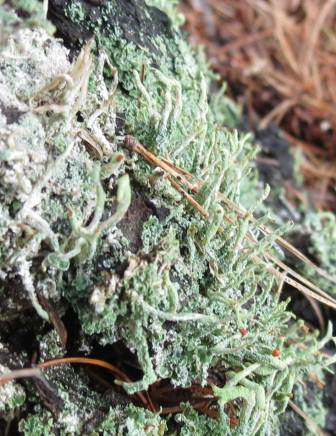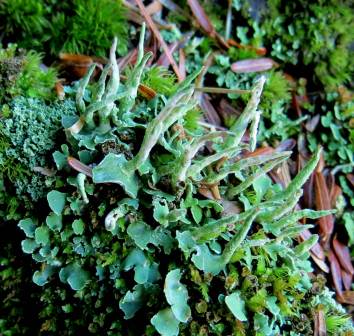This is the second part of a two part post about an old abandoned road here in Keene, New Hampshire. To read part one just scroll down or click here.
As I said in part one, there are many wildflowers that grow along this old road and this one, blue stemmed goldenrod (Solidago caesia), is rare in this area. This road is one of only two places that I know of to find this plant. With its little tufts of flowers spread out along its stem it is one of the easiest goldenrods to identify. The “blue stem” comes from the waxy coating on the stem that protects it from sunlight and helps hold in moisture. It is very similar to the whitish “bloom” seen on blueberries.
A closer look at the flowers of blue stemmed goldenrod.
Wildflowers aren’t the only plants found here. Poison ivy (Toxicodendron radicans) runs rampant on both sides of the road. This isn’t the place to be hiking with shorts on.
On the side of the road opposite Beaver Brook ledges soar quite high in places. These ledges were cut out of the bedrock by hand, long before there were power tools to do the job.They are great places to find mosses and lichens.
I found these common powderhorn lichens growing on one of the ledges. There are very similar to British soldier lichens, but without the red tips.
You can still see evidence of the star drills that were used to drill into the stone, which happens to be feldspar in this example. Star drills were long pieces of steel with a star shaped tip that were held by one man while two others hit the end with sledge hammers. After each hammer blow the drill would be rotated 1/8 turn and eventually a hole would be cut into the stone. A good team could do about 12 holes per day. Once enough holes were drilled small tools called feathers and wedges were tapped into each one to split the stone away from the ledge face. Then all of the fallen stone would have had to have been put into ox carts and hauled away. This was very labor intensive and it took a long time to cut a road through solid rock. This is why old roads were so full of curves-they followed the path of least resistance.
Beaver Brook cascades over ledges into a small, shaded pool that was once a popular swimming hole. There seems to be a lot of conflicting information about how high the falls are. I’ve heard everything from 10 feet to 100 feet, but I’d guess that they are closer to 30 to 40 feet and maybe 50 if you include the part that isn’t visible in this photo. They are certainly high enough to allow me to say with certainty that you wouldn’t catch me jumping off those ledges.
If you’d like to see a very short video from above the falls taken by someone with absolutely no fear of heights, just click here. You’ll also be able to hear the great roar of the falls.
NOTE: What the person who shot this video did was extremely dangerous because of the crumbling cliff faces and I would strongly urge others to not try it. I hope he at least had a rope around his waist!
A lot of people come here to see the falls, but to get a clear view of them like that in the photo you have to climb/ slide / fall down a very steep embankment and then climb over large boulders. I did all of that 6 or 7 times trying to get photos for this post and I’m glad I don’t have to do it again right away. This photo shows a hint of the large stone in the center of the lower part of the falls that splits them in two in dry weather. Beaver Brook’s headwaters are in Gilsum, New Hampshire, north of Keene, and when the falls are split in half, you know that it has been very dry there.
This old hand colored postcard shows the falls split in two due to dry weather. This photo was taken sometime around 1910 and if you look very closely above and to the right of the falls you can see a woman sitting on a ledge with her feet hanging over. There is a bare tree branch hanging down just behind her on her right. (Our left) She is wearing a long, rose colored dress and a big, wide brimmed hat. Most of these old photos and postcards have people in them somewhere, but I’m not sure why. It’s possible that it was done to give an idea of scale, which this lady does very well. Maybe she had been diving into the pool from the ledges and was resting.
I know why the lady in the rose colored dress needed a rest! If you think getting down to the brook to get photos of the falls was difficult, just wait until you have to climb back up carrying cameras and a tripod! It’s close to vertical but with just enough slant to make it possible.
Here is a view of the falls circa 1900 that you can’t see today because trees and brush block the view. It seems amazing to me that this land was once so clear, with hardly a bush or tree on the hillsides. If it wasn’t for their roar you could walk right past the falls today while hardly getting a glimpse of them.
If you’re wondering if there is a person in this postcard the answer is yes. He or she is standing on the road beside the white fence just about even with the falls. It’s either a woman wearing a long black dress with a white collar or a man with a long white beard wearing a long black coat. This postcard was made from a hand colored black and white photograph.
If you were to follow the road in the postcard view today you would run smack into one of the biggest piles of dirt you had ever seen. All of the fill that the “new” Route 9 North sits on had to be trucked in from elsewhere when the highway was built in the late 70s. It’s amazing to think that what was once a footpath beside a brook, used by Native Americans to hunt and fish from, is now a multi-lane highway. This was and is an important route north out of Keene and now leads to Concord, the state capital.
If you stand on the highway and look down you can still see part of the original old road. This view is on the opposite side of the highway from the falls that we were just visiting and the old road isn’t as overgrown. The highway was built directly across the road, cutting it off from motorized travel forever.
The old road was originally built to access a sawmill which was built on Beaver Brook in 1736. In 1735 100 acres of “middling good land” and 25 pounds cash was offered to anyone who could build a sawmill capable of furnishing lumber to the settlement of Upper Ashuelot, which is now called Keene. Without a sawmill you lived in a log cabin, so they were often built before anything else in early New England settlements.
If you follow Beaver Brook upstream from the falls and across the new highway you will eventually come to this dam, built by the U.S. Army Corps of Engineers in 1986. The dam has saved Keene from devastating floods several times, but it does not completely eliminate all flooding in the city. At capacity Beaver Brook Dam can hold back 106 acres of floodwaters.
Beavers are still here doing their part in finding flood control solutions too.
When flooding doesn’t occur the area behind the dam is essentially the same wetland, called “three mile swamp,” that it has always been. This is a great place to spot wildlife. As I was gathering photos for this post I saw ducks, geese, and a great blue heron who sat on a dead tree branch just out of camera range.
Well, now you folks know as much about this old rad and the surrounding area as I do. I hope it was an enjoyable excursion and I thank you for coming along.
We live in a wonderful world that is full of beauty, charm and adventure. There is no end to the adventures we can have if only we seek them with our eyes open. ~ Jawaharial Nehru

















 This is also a beard lichen called bristly beard (Usnea hirta.) many lichens grow so slowly that they can take decades to grow a fraction of an inch. They are thought to be among the oldest living things on earth.
This is also a beard lichen called bristly beard (Usnea hirta.) many lichens grow so slowly that they can take decades to grow a fraction of an inch. They are thought to be among the oldest living things on earth.


 Common powderhorn lichens (Cladonia coniocraea) look just like lipstick powderhorns, but without the red tip. The spores are released from the pointed tip. These were also growing on a decaying log.
Common powderhorn lichens (Cladonia coniocraea) look just like lipstick powderhorns, but without the red tip. The spores are released from the pointed tip. These were also growing on a decaying log.







